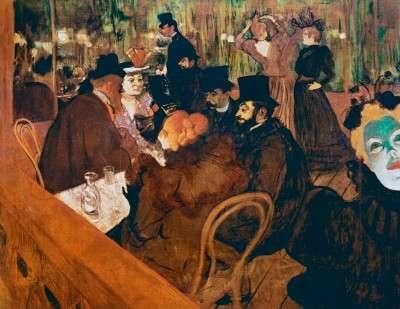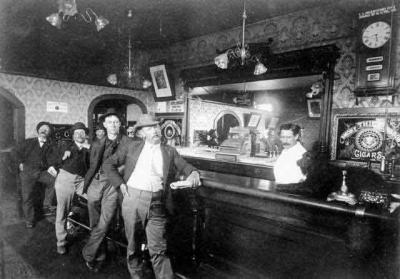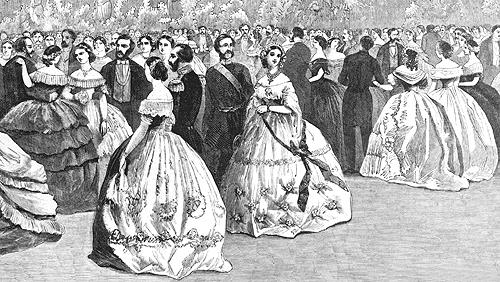Historical Hatiquette (Hat Etiquette)
The subject often comes up at living histories and vintage dances of when a gentleman should wear a hat and when he should remove it. While the stuff they told me in the Army about "Hats on outdoors--hats off indoors" is not a bad rule of thumb, in historical practice, it wasn't always that simple.
I am addressing issues of what you do with a hat depending on where you are. When you remove your hat in the presence of ladies is another matter entirely.
 I will confine myself to the 19th and 20th Centuries. In pre-French Revolutionary Europe, there were so many rules relating to social hierarchy, that it requires a separate discussion. I will also preface this by observing that Americans, especially in the first half of the 19th Century, were notorious for their rough manners, and the presence of hats on men in theaters, homes and the floor of the US Senate, was commented upon unfavorably by foreigners.
I will confine myself to the 19th and 20th Centuries. In pre-French Revolutionary Europe, there were so many rules relating to social hierarchy, that it requires a separate discussion. I will also preface this by observing that Americans, especially in the first half of the 19th Century, were notorious for their rough manners, and the presence of hats on men in theaters, homes and the floor of the US Senate, was commented upon unfavorably by foreigners.
Generally, for the 19th Century man, the hat remained on outdoors, and in fact, a man outdoors without a hat would be a subject of comment (sorry dashing young Hollywood hunks). However, once indoors, the topic gets a little muddier.
The decider seemed to be the public/private nature of the space. In a public space like a train station, hotel lobby, a saloon or a public dance hall, the hat usually remained on. It is very striking in the numerous paintings of the Moulin Rouge in Paris, that all the men have their top hats glued to their heads, even when sitting at tables with apparently respectable ladies. The only thing that seems to get them off their heads is a swift kick from a high stepping can-can dancer. Probably one major consideration in a place as crowded and turbulent as the Moulin Rouge, or a saloon or chop house, is that there really was no safe place to leave the hat, and the hands had drinks to lift and other work to do.
The same hattedness applied to patrons at retail establishments. The customers kept their hats on, though the staff generally did not wear hats while working. In an office, both employees and visitors would remove their hats, and a well managed office would provide a place for such things to be stowed.
It appears that in situations when hands were likely to be full of luggage or merchandise or other cargo, a gentleman did not need to find additional space in his hands to hold his hat.
However, in more respectable spaces like restaurants (as opposed to chop houses) the hats would be removed before taking one's seat. Proper sorts of establishments provided convenient pegs upon which hats and other impedimenta could be hung.
 Orators would also remove their hats while speaking--even when outdoors, so that the audience might observe their facial expressions. This proved fatal for President W.H. Harrison. In theaters also, the hat would be removed once the gentleman took his seat, if only out of consideration for those sitting behind. Ideally, it would be checked with the topcoat in the cloakroom (an essential part of any respectable establishment of yore - but largely extinct in 21st Century California). Lacking a cloak room, the hat would be held in the lap. A gentleman might also not trust a cloak room to deliver HIS black top hat to him out of the legions of identical black top hats. For such non-trusting gents, the collapsible opera hat was developed.
Orators would also remove their hats while speaking--even when outdoors, so that the audience might observe their facial expressions. This proved fatal for President W.H. Harrison. In theaters also, the hat would be removed once the gentleman took his seat, if only out of consideration for those sitting behind. Ideally, it would be checked with the topcoat in the cloakroom (an essential part of any respectable establishment of yore - but largely extinct in 21st Century California). Lacking a cloak room, the hat would be held in the lap. A gentleman might also not trust a cloak room to deliver HIS black top hat to him out of the legions of identical black top hats. For such non-trusting gents, the collapsible opera hat was developed.
However, in private spaces, the rules were different. When entering a home a hat was generally removed immediately upon entering (and given to a servant if one were present). In a brief visit, such as a "call of ceremony", the hat would be removed, but retained in the hand.
Hats would also be removed when entering private clubs.
Also, with a special relevance to current "dress-up" activities, hats would never be worn in a ballroom at a respectable private or subscription ball (such as the Social Daunce Irregulars Victorian Ball), though hats could be worn if dancing outdoors, or while spinning a floozy around the floor in a dockside dive.
Note that the same rules apply to military and non-military gentlemen.
A final note: to mitigate "hat hair", hair oil was widely worn.
Related Posts

(This is a reposte and update of a post on my old blog from 2007)
